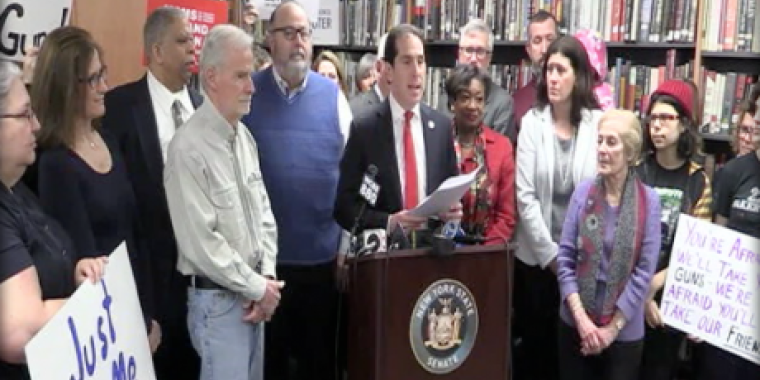LI group tied to chemical company files suit to overturn new water standards
A lawsuit backed by a major chemical company seeks to overturn the state’s new drinking water standard for the likely carcinogen 1,4-dioxane.
The suit argues Long Island should turn to alternative sources for its tap water instead of spending hundreds of millions of dollars on treatment.
The petition, filed by the nonprofit group Long Island Pure Water in state court late last month, said the New York Department of Health didn’t base its standard on science and failed to prepare a cost-benefit analysis.
Instead of regulating the contaminant, the suit argues the state should have required Long Island to connect to New York City’s cleaner water source, derived from upstate rivers and reservoirs, or draw from beneath the protected central pine barrens in Suffolk.
"This is about finding a long-term comprehensive solution that protects residents and avoids massive costs," said Nick Rigano, a partner at Melville-based law firm Rigano LLC, which represents the group. He confirmed the group received funding from Dow Chemical, which is being sued by dozens of Long Island water providers.
State Department of Health spokesman Gary Holmes said in a statement that the regulations created with the guidance of a panel of experts "set protective, achievable and enforceable standards for emerging contaminants and were subject to extensive public comment. The Department does not comment on pending litigation."
Environmental groups said New York’s regulation of 1,4-dioxane protects Long Islanders from the chemical that has been found in two-thirds of public supply wells on Long Island.
"It’s appalling that anyone would fight against drinking water and public health protection. This is a legal battle that hurts every single Long Islander," said Adrienne Esposito, executive director of Citizens Campaign for the Environment.
The first-in-the-nation drinking water standard for 1,4-dioxane went into effect this past summer, though water providers have applied for waivers to have more time to come into compliance. Providers have been scrambling to install treatment systems that could total $840 million for capital costs and ongoing operations and maintenance.
Long Island Pure Water, which has unsuccessfully sued over contamination in Bethpage from the Grumman Plume, describes itself on the website as a "citizens group" focused on providing a "sustainable pure drinking water source."
Rigano acknowledged the Michigan-based Dow Chemical "is providing some financial support" for the lawsuit. He said he had reached out to other organizations for funding. He declined to say how much Dow has contributed.
Dozens of Long Island water districts are suing Dow and other companies that manufactured 1,4-dioxane for contamination. The chemical had been used as an additive with solvents.
A Dow Chemical spokeswoman confirmed they are supporting Long Island Pure Water and its legal challenge.
"We strongly believe that a water sharing solution would provide the citizens of Long Island with sustainable, cost-effective access to clean, plentiful and reliable drinking water for decades to come," spokeswoman Ashley Mendoza said in a statement.
Esposito said the effort seemed to be "your classic ‘green washing’ — pretending to be an environmental group when you’re doing the bidding of an industry."
State Sen. Todd Kaminsky (D-Long Beach) said the lawsuit is "misplaced at best."
The state was faced with widespread contamination, and had to face the decision to either try to address it or ignore it.
"The alternative, which people make very scary movies about, is you find contaminants and move on," Kaminsky said. He also supported moving ahead with a state Department of Health study on connecting Long Island to New York City water.
The state this summer adopted a standard of 1 part per billion for 1,4-dioxane. Chronic, lifelong exposure to 0.35 ppb of 1,4-dioxane represents a one-in-a-million cancer risk, according to the U.S. Environmental Protection Agency. The fact that the state adopted a drinking water standard nearly three times higher disappointed some environmental and health advocates, who pushed for a more protective limit.
The lawsuit challenges the safety of the treatment technology used to remove the chemical. Known as advanced oxidation processes, or AOP, it hadn’t been approved in the state until last year.
That process can produce toxic byproducts. The lawsuit said the technology has never been this widely implemented, and treatment at public drinking water wells should be a last resort.
"Long Islanders should not be treated as guinea pigs," according to the suit. It says that New York City or central Pine Barrens water "could provide a permanent solution to Long Island’s decadeslong drinking water problem and avoid the current path of massive misdirected expenditures for unproven, risky treatment systems."
Water providers said byproducts created by the AOP treatment are filtered out with other treatments before being delivered through taps.
"From a public water supply treatment, we don’t think the AOP process is a dangerous process," said Dennis Kelleher, spokesman for the Long Island Water Conference, which represents over 50 water suppliers. The group, which had raised concerns about implementing the standard, doesn’t have a position yet on the lawsuit.
"We do think the regulations were maybe put through too quickly," he said. But once implemented, water providers had one option to meet the drinking water standard.
Connecting to New York City water, he said, would take "years, if not decades."
Esposito said the concept of taking water from New York City to Nassau County "has meaningful promise. But it would be used to supplement our groundwater, not replace our groundwater" and the water in the aquifer should still be treated.


